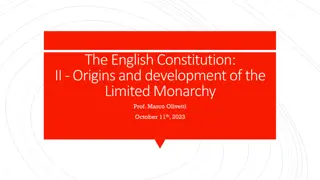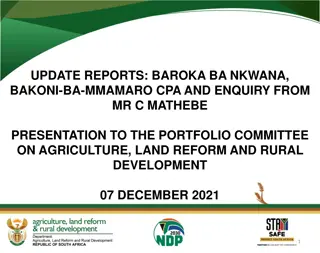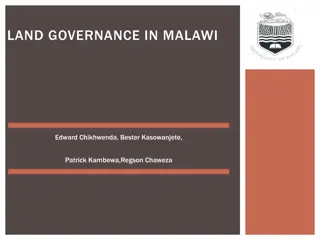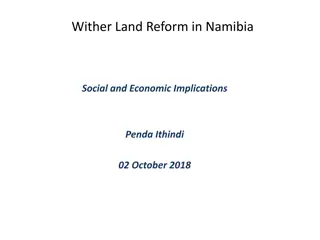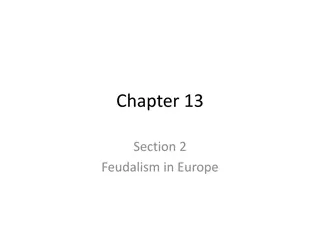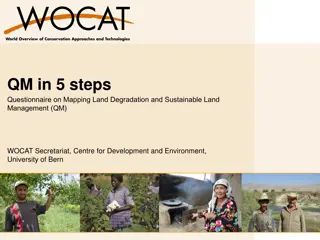Feudalism and Land Grants in Medieval History
Feudalism was a complex system that influenced all aspects of life in the Middle Ages, based on land tenure and obligations. Land grants played a significant role in organizing land relations, with grants to various beneficiaries shaping agrarian societies.
Download Presentation

Please find below an Image/Link to download the presentation.
The content on the website is provided AS IS for your information and personal use only. It may not be sold, licensed, or shared on other websites without obtaining consent from the author.If you encounter any issues during the download, it is possible that the publisher has removed the file from their server.
You are allowed to download the files provided on this website for personal or commercial use, subject to the condition that they are used lawfully. All files are the property of their respective owners.
The content on the website is provided AS IS for your information and personal use only. It may not be sold, licensed, or shared on other websites without obtaining consent from the author.
E N D
Presentation Transcript
What is Feudalism What is Feudalism It was a system which influenced not only one but every sphere of life. It was one of the complicated developments of the Middle Ages. It appeared in a variety of forms. Although it existed in some form or other in different parts of Europe, the basic nature of the system remained almost the same. Hence, it becomes easier for us to understand the system to a great extent.
Feudalism has been defined variously by different scholars. One of the most suitable definitions of feudalism is a complete organisation of society through the medium of land tenure in which from the king down to the lowest land-holder all are bound together by obligation and fence The term feudalism has been derived from the word feud which means fief. Fief was a type of fee or a kind of remuneration which a landlord used to grant to his vassals in return for the services rendered by the latter to the former. The nature of services could be military agrarian or both. In medieval Europe, the feudal system mainly prevailed on the basis of land holding.
Land Grants Land Grants The early medieval period in Indian history marks the growth of cultivation and organisation of land relations through land grants. These grants began around the beginning of Christian era and covered practically the entire sub-continent by the end of the twelfth century. The centuries between the eighth and twelfth witnessed the processes of this expansion and the culmination of an agrarian organisation based on land grants to religious and secular beneficiaries, i.e., Brahmanas, temples and officers of the King s government.
The chronological appearance of the land grant system shows the following pattern: Fourth-fifth centuries: Spread over a good part of Central India, northern Deccan and Andhra Fifth-Seventh Centuries: Eastern India (Bengal and Orissa), beginnings in Western India( Gujarat and Rajasthan) Seventh and Eighth Centuries: Tamil Nadu and Karnataka Ninth Century : Kerala End of the Twelfth Century : Almost the entire sub- continent with the possible exception of Punjab
Brahmadeya Brahmadeya A brahmadeya represents a grant of land either in individual plots or whole village given away to Brahmanas making them landowners or land controllers. It was meant either to bring virgin land under cultivation or to integrate existing agricultural(or peasant) settlements into the new economic order dominated by a Brahmana proprietor.
The practice of land grants as Brahmadeyas was initiated by the ruling dynasties and subsequently followed by chiefs, feudatories, etc. Brahmadeyas facilitated agrarian expansion because they were: Exempted from various taxes or dues either entirely or at least in the initial stages of settlement. Also endowed with ever growing privileges(pariharas). The ruling families derived economic advantage in the form of the extension of the resource base, moreover, by creating brahmadeyas they also gained ideological support for their political power.
Secular Grant Secular Grant
Various Types of Vassals Various Types of Vassals
Obligations of Vassals Obligations of Vassals
Economic Aspect of Feudalism Economic Aspect of Feudalism Decline in Trade and Commerce Decline in Urban Centre Creation of self economy Decline in Trade and Commerce Decline in Urban Centre Creation of self- -sufficient economy sufficient
Historical Role of Feudalism Historical Role of Feudalism Merits Demerits Merits Demerits
Merits Merits Expansion of Agriculture Expansion of Agriculture Spread of Agricultural Knowledge(Treatise like Parasara Spread of Agricultural Knowledge(Treatise like Krishi Parasara- -an example) Krishi an example) Tribal areas coming under the influence of Aryan Civilisation and the Tribal Chief becoming Tribal areas coming under the influence of Aryan Civilisation and the Tribal Chief becoming Kshyatria Kshyatria
Demerits Demerits Economic Decay Social Division Political Disintegration Administrative Decentralisation Rise of Regional Culture Economic Decay Social Division Political Disintegration Administrative Decentralisation Rise of Regional Culture
Debates on Indian Feudalism Debates on Indian Feudalism
Conclusion Conclusion



